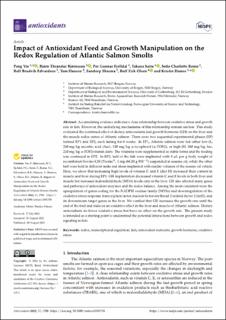| dc.contributor.author | Yin, Peng | |
| dc.contributor.author | Bjørnsson, Bjørn Thrandur | |
| dc.contributor.author | Fjelldal, Per Gunnar | |
| dc.contributor.author | Saito, Takaya | |
| dc.contributor.author | Remø, Sofie C. | |
| dc.contributor.author | Edvardsen, Rolf Brudvik | |
| dc.contributor.author | Hansen, Tom Johnny | |
| dc.contributor.author | Sharma, Sandeep | |
| dc.contributor.author | Olsen, Rolf Erik | |
| dc.contributor.author | Hamre, Kristin | |
| dc.date.accessioned | 2022-09-21T09:41:50Z | |
| dc.date.available | 2022-09-21T09:41:50Z | |
| dc.date.created | 2022-09-05T15:03:28Z | |
| dc.date.issued | 2022-08-30 | |
| dc.identifier.issn | 2076-3921 | |
| dc.identifier.uri | https://hdl.handle.net/11250/3020145 | |
| dc.description.abstract | Accumulating evidence indicates a close relationship between oxidative stress and growth rate in fish. However, the underlying mechanisms of this relationship remain unclear. This study evaluated the combined effect of dietary antioxidants and growth hormone (GH) on the liver and the muscle redox status of Atlantic salmon. There were two sequential experimental phases (EP) termed EP1 and EP2, each lasting for 6 weeks. In EP1, Atlantic salmon were fed either low-(L, 230 mg/kg ascorbic acid (Asc), 120 mg/kg α-tocopherol (α-TOH)), or high-(H, 380 mg/kg Asc, 210 mg/kg α-TOH)vitamin diets. The vitamins were supplemented as stable forms and the feeding was continued in EP2. In EP2, half of the fish were implanted with 3 μL per g body weight of recombinant bovine GH (Posilac®, 1 mg rbGH g BW−1) suspended in sesame oil, while the other half were held in different tanks and sham-implanted with similar volumes of the sesame oil vehicle. Here, we show that increasing high levels of vitamin C and E (diet H) increased their content in muscle and liver during EP1. GH implantation decreased vitamin C and E levels in both liver and muscle but increased malondialdehyde (MDA) levels only in the liver. GH also affected many genes and pathways of antioxidant enzymes and the redox balance. Among the most consistent were the upregulation of genes coding for the NADPH oxidase family (NOXs) and downregulation of the oxidative stress response transcription factor, nuclear factor-erythroid 2-related factor 2 (nrf2), and its downstream target genes in the liver. We verified that GH increases the growth rate until the end of the trail and induces an oxidative effect in the liver and muscle of Atlantic salmon. Dietary antioxidants do lower oxidative stress but have no effect on the growth rate. The present study is intended as a starting point to understand the potential interactions between growth and redox signaling in fish. | en_US |
| dc.language.iso | eng | en_US |
| dc.publisher | MDPI | en_US |
| dc.rights | Navngivelse 4.0 Internasjonal | * |
| dc.rights.uri | http://creativecommons.org/licenses/by/4.0/deed.no | * |
| dc.title | Impact of Antioxidant Feed and Growth Manipulation on the Redox Regulation of Atlantic Salmon Smolts | en_US |
| dc.type | Journal article | en_US |
| dc.type | Peer reviewed | en_US |
| dc.description.version | publishedVersion | en_US |
| dc.rights.holder | Copyright 2022 the authors | en_US |
| dc.source.articlenumber | 1708 | en_US |
| cristin.ispublished | true | |
| cristin.fulltext | original | |
| cristin.qualitycode | 1 | |
| dc.identifier.doi | 10.3390/antiox11091708 | |
| dc.identifier.cristin | 2048946 | |
| dc.source.journal | Antioxidants | en_US |
| dc.relation.project | Bergesenstiftelsen: BFS2017TMT04 | en_US |
| dc.relation.project | Norges forskningsråd: 245979 | en_US |
| dc.relation.project | Bergesenstiftelsen: BFS2017TMT08 | en_US |
| dc.identifier.citation | Antioxidants. 2022, 11 (9), 1708. | en_US |
| dc.source.volume | 11 | en_US |
| dc.source.issue | 9 | en_US |

